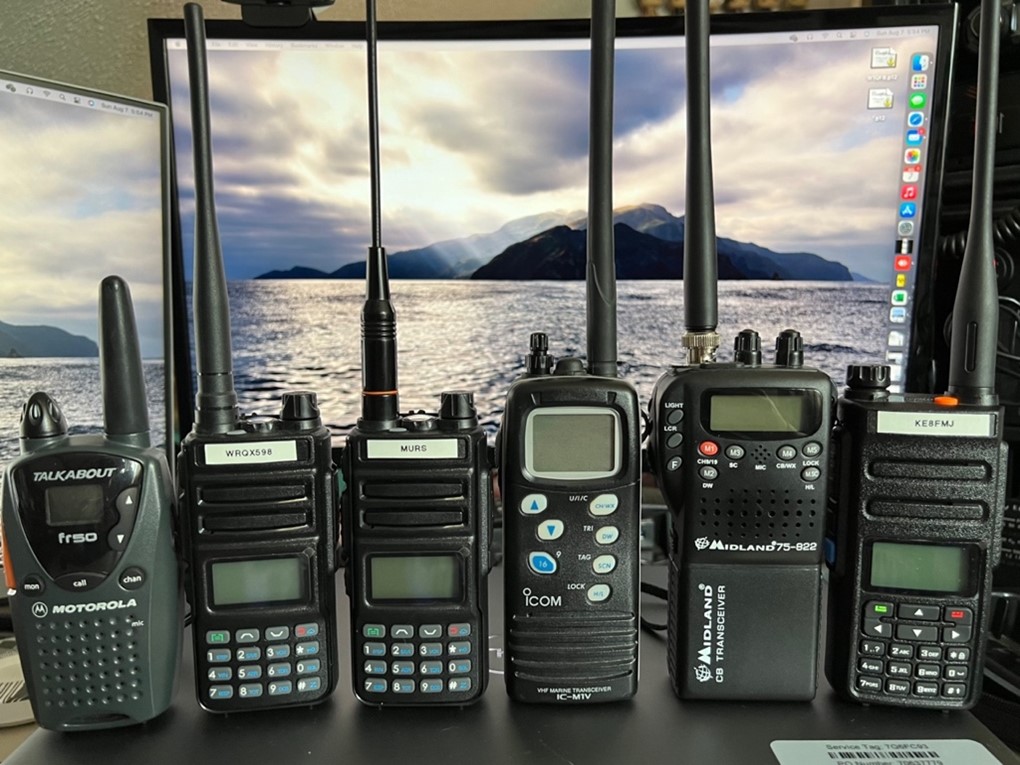So, we have discussed analog ham radio. We have discussed digital ham radio. We have talked about the quality brands and touched upon the cheaper brands. We’ve even explored accessories of all kinds. Is that all that is left for HTs? Let’s continue our handy talky overview with Part 4 of our series: Other Communication Types.
There is always more for handy talky lovers! From General Mobile Radio Service (GMRS) to Marine Band, from Air Band to Citizens Band (CB), there is a handy talky for them all.

Just a few other communication types in my collection. We have Family Radio Service (FRS), GMRS, Multi-Use Radio Service (MURS), Marine Band, CB, and Airband handy talkies.
FRS: The Family Radio Service is an improved walkie-talkie radio system authorized in the U.S. in 1996. This personal radio service uses channelized frequencies around 462 and 467 MHz in the UHF band. It does not suffer the interference effects found on CB at 27 MHz or the 49 MHz band also used by cordless telephones, toys, and baby monitors. FRS uses FM instead of AM. Since the UHF band has different radio propagation characteristics, short-range use of FRS may be more predictable than the more powerful license-free radios operating in the HF CB band.
GMRS: This is a land-mobile FM UHF radio service designed for short-distance two-way communication. It requires a license in the U.S., but some GMRS-compatible equipment can be used license-free in Canada. The U.S. GMRS license is issued for a period of 10 years by the Federal Communications Commission (FCC). The U.S. permits use by adults who possess a valid GMRS license, as well as their immediate family members. Immediate relatives of the GMRS system licensee are entitled to communicate among themselves for personal or business purposes, but employees of the licensee who are not family members are not covered by the license. Non-family members must be licensed separately.
MURS: In the U.S., the Multi-Use Radio Service is a two-way radio service similar to the Citizens Band. Established by the FCC in 2000, MURS allows for operation in a narrow selection of the VHF band, with a power limit of two watts. The FCC defines MURS as “a private, two-way, short-distance voice or data communications service for personal or business activities of the general public.” MURS stations may not be connected to the public telephone network and may not be used for store and forward operations. Radio repeaters are not permitted.
Marine Band: This worldwide system of two-way radio transceivers is used for bidirectional voice communication from ship-to-ship, ship-to-shore, and, in certain circumstances, ship-to-aircraft. It uses FM channels in VHF in the frequency range between 156 and 174 MHz, designated by the International Telecommunication Union as the VHF maritime mobile band. In some countries additional channels are used, such as the L and F channels for leisure and fishing vessels in Nordic countries. Transmitter power is limited to 25 watts, giving a range of about 62 miles.
CB: CB is a land-mobile radio system that allows short-distance, person-to-person bidirectional voice communication using two-way radios operating on 40 channels near 27 MHz (11 meters) in the high frequency band. In many countries, CB operation does not require a license, and unlike amateur radio, it may be used for business or personal communications. Like many other land-mobile radio services, multiple radios in a local area share a single frequency channel, but only one can transmit at a time. Transmitter power is limited to four watts in the U.S. and the E.U. CB radios have a range of about three miles to 20 miles depending on terrain, for line-of-sight communication; however, various radio propagation conditions may intermittently allow communication over greater distances.
Airband: Airband, or aircraft band, is the name for a group of frequencies in the VHF radio spectrum allocated to radio communication in civil aviation. Different sections of the band are used for radio navigational aids and air traffic control. The VHF Airband uses the frequencies between 108 and 137 MHz. The lowest 10 MHz of the band, from 108 to 117.95 MHz, is split into 200 narrow-band channels of 50 kHz.
In most countries, a license to operate Airband equipment is required, and the operator is tested on competency in procedures, language, and the use of the phonetic alphabet.
Questions? Have a fun digital to share? Share them in the comments below or email me at KE8FMJ@gmail.com.

